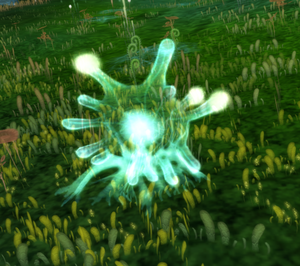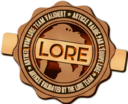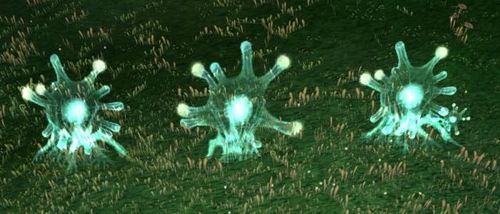Difference between revisions of "Dziku"
From EncyclopAtys
m |
m |
||
| Line 1: | Line 1: | ||
| − | {{Lore Officielle}}{{Trad | + | {{Lore Officielle}}{{MobInfoBox |
| + | |image=Dziku.png | ||
| + | |name=Dziku | ||
| + | |king=Fauna | ||
| + | |species=[[:Category:False plants|False plant]] | ||
| + | |locale=[[Primes]] | ||
| + | |aggro= No | ||
| + | |damage=None | ||
| + | |}}<noinclude>{{Trad | ||
|DE=Dziku | |DE=Dziku | ||
|DEs=4 | |DEs=4 | ||
| Line 5: | Line 13: | ||
|ENs=4 | |ENs=4 | ||
|ES=Dziku | |ES=Dziku | ||
| − | |ESs= | + | |ESs=4 |
|FR=Dziku | |FR=Dziku | ||
|FRs=0 | |FRs=0 | ||
| Line 11: | Line 19: | ||
|RUs=5 | |RUs=5 | ||
|H= | |H= | ||
| − | |palette=primes}} | + | |palette=primes}}</noinclude> |
| − | |||
| − | |||
| − | |||
| − | |||
| − | |||
| − | |||
| − | |||
| − | |||
| − | |||
The '''dziku''' (known as '''[[amoeba]]''' in the [[Kitin's Lair]] of [[Almati Wood]]) is also an animal, of the same family as the [[cokamool]]. | The '''dziku''' (known as '''[[amoeba]]''' in the [[Kitin's Lair]] of [[Almati Wood]]) is also an animal, of the same family as the [[cokamool]]. | ||
| Line 31: | Line 30: | ||
The [[homins]] have no use for it. | The [[homins]] have no use for it. | ||
<noinclude>[[File:Dzikus.jpg|500px|thumb|left|Three dzikus]]</noinclude> | <noinclude>[[File:Dzikus.jpg|500px|thumb|left|Three dzikus]]</noinclude> | ||
| − | {{Clear}} | + | {{Clear}}{{Last version link|Dziku}}<noinclude>{{Portal|Flora}} |
| − | {{Last version link|Dziku}} | ||
| − | {{Portal|Flora}} | ||
[[Category:Flora]] | [[Category:Flora]] | ||
| − | |||
[[Category:False plants]] | [[Category:False plants]] | ||
| − | [[Category:Flora of the Primes]] | + | [[Category:Flora of the Primes]]</noinclude> |
Revision as of 18:09, 13 November 2019
Page proposed to the Lore of Ryzom
Latest edition: Lanstiril, 13.11.2019
| Taxonomic Amber | |
| Dziku | |
|---|---|

| |
| Kingdom | Fauna |
| Category | False plant |
| Main Ecosystem(s) | Primes |
| Counterattack type | None |
The dziku (known as amoeba in the Kitin's Lair of Almati Wood) is also an animal, of the same family as the cokamool.
Unlike its cousin it is not composed of multiple small replicas of itself and develops no protective shell. The outer face is flexible and non-yielding to touch.
It bears a multitude of bioluminescent stinging hairs on some of its tips (harmless to larger animals) which allow it to attract and catch the microorganisms which it feeds upon.
The inside is 98% water. The denser central part is its stomach.
The homins have no use for it.
Last version 2019-11-13•ᐒ





